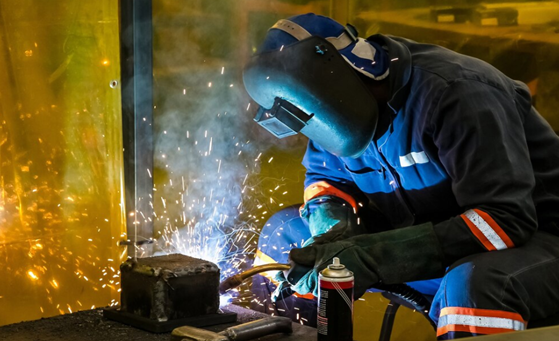Welding is potentially hazardous and involves a lot of risk; it requires welders to wear appropriate protective gear. Below is a breakdown of the various protective gear that every welder must wear to ensure their safety and protection during the welding process.
1. Welding Helmets/Hoods
Welding helmets or hoods are not just another piece of protective gear; they offer the best shield against the bright light and heat of welding. They are crucial for your safety, offering a sense of security and protection.
With various types available, such as the auto-darkening welding helmet, which can change lens shade automatically, you can find the one that best suits your needs. If you want to protect yourself from hazards and injuries while welding, choosing a sugar scoop hood or pancake hood is also the best option.
2. Welding Gloves
Welding gloves are meant to shield your hands from heat, sparks, and spatter. Most welders find it hard to withstand the heat and pressure. These gloves are available in various types, such as the MIG gloves, TIG gloves, and stick welding gloves, so that you can make the right choice based on your needs.
3. Welding Aprons
Flame-resistant clothing, such as welding aprons, is worn to shield your body from sparks and spatter. They are made from leather or fabrics that do not easily catch fire and can be manufactured in various sizes and models.
4. Respirators
Protective devices – such as respirators, also help to keep the welders’ lungs shielded from these welds, fumes, and gaseous substances. The versatile devices comprise disposable respirators and air-purifying respirators. Any respirators used during welding operations have to comport with the OSHA respiratory protection standard.
5. Safety Glasses
Safety eyeglasses are used to shield your eyes from objects that may be thrown around or small particles flying in the air. These glasses are available in different styles and sizes to meet the diverse needs of welders while they are on their work.
6. Welding Goggles
Regarding the type of protection, welding goggles are very much like welding helmets, but they are much smaller and protect only the vision area. Welders use them in low-current applications, such as TIG welding. That’s why they better fit some welders compared to standard ones.
7. Face shields
Another type of eye protection gear that welders must wear during the welding process is a face shield. If you use it, it will protect your whole face and shield against the adverse impacts of falling particles, arcs of sparks, and chemical splashes.
Welders wear face shields together with other types of eyewear, including goggles or even a welding helmet with an attached visor. So they can flip it up to cover their eyes adequately.
8. Fire-resistant Jackets
These jackets are made of fabrics that do not easily catch fire or burn up quickly. While welding metals, you can use them to shield your upper body from sparks, spatter, and heat.
Some of the most common types of fire-resistant jackets are made from materials such as leather, cotton, and synthetic fabrics.

